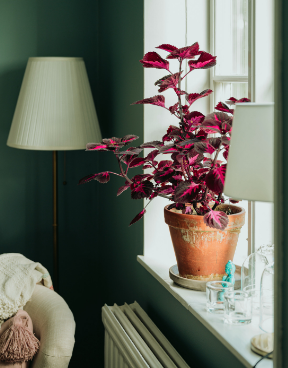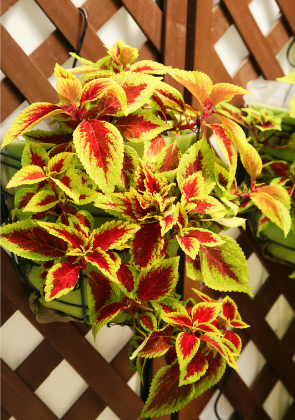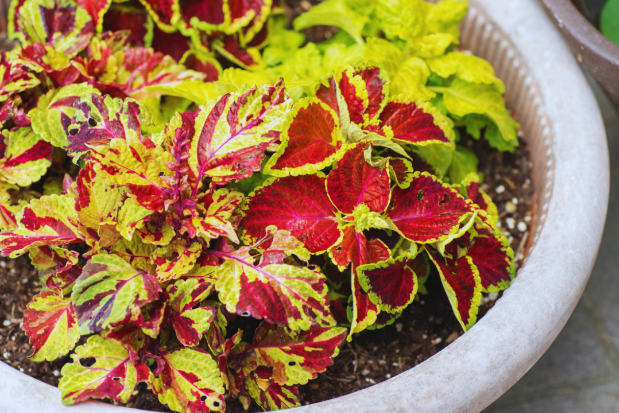Coleus plants are annual perennials that make for both an indoor and outdoor plant. They have some of the most stunningly colored foliage. The pigmented leaf patterns have bright vibrant foliage colours filled with solid colors, splashes, streaks, flecks, margins, and veins. The colour intensity of the leaves also varies, depending on sunlight, heat sensitivity, and other conditions. It is true that they don’t produce very showy flowers but don’t let that stop you. Because of its crazy colour combinations and leaf patterns of green, yellow, pink, red, maroon, no matter what area you are looking to put coleus, you can find one that will be perfect. Their unique appearance and ease of care make them a popular houseplant choice for both novice and experienced gardeners. Here's how you can easily grow coleus plants in your home-
Coleus For Pots, Planters, and Borders
- Coleus adapts to life in pots and planters, as well as flower beds and borders.
- A plant that is kept in a small pot will remain small.
- Use coleus in terrace boxes, patio planters, and hanging baskets in direct sunlight. Also, because their semi-succulent stems are prone to breakage, pick a wind-protected location.
- Keep in mind that coleus are thirsty, and a hanging basket might quickly dry out; for the best results, consider a self-watering basket.
- If you move it to a larger pot or into the open garden, it can reach a height of almost 2 feet in the summer if adequately fed.
WATER, SUNLIGHT & SOIL CARE NEEDS OF COLEUS PLANTS

(Image Coleus Red in 6 Inch Plastic Pot Via urvann)
WATER- Coleus plants need to be watered on a regular basis. It's critical to maintain the soil of your coleus plants consistently moist throughout the year, however you may usually lessen your watering frequency in the winter. The soil of a coleus plant should never be allowed to dry out.
SUNLIGHT- Coleus plants prefer bright light, however direct midday sunshine, which can scorch the fragile leaves, is best avoided. Find a windowsill or other location in your home that receives direct sunshine in the morning and brilliant, filtered light in the afternoon. It'll be a delicate balancing act—too much sun can fade the plant's vivid leaves, while too little can result in dull colours.
IDEAL SOIL MIX- Plant your coleus in a moist but well-draining soil combination. A general potting mix will usually be adequate, but if you see that your soil is becoming too wet, you can amend it with a bit of perlite or vermiculite to help with drainage.
Coleus Pruning and Pinching
When it comes to caring for coleus, pruning is key. Colourful, low-maintenance coleus plants also benefit greatly from trimming or pinching back to encourage dense growth and to improve their appearance, particularly if they develop legginess from growing under low-light conditions.
- PRUNING-The main goal of pruning coleus is to encourage branching and a more dense foliage cover, which is highly desirable in a foliage plant like coleus. Pruning in the traditional sense is only needed to tighten leggy growth or to remove dead stems, Cutting back coleus will actually produce more of it, making the plant take on a bushier shape quite quickly.
- PINCHING- To pinch back your coleus, simply cut or pinch off any stem at a point where two stems or two leaves are growing from it. Two new branches will begin to grow from where those other stems or leaves meet the main stem that you pinched.. Pinching off the flower heads of coleus should be done throughout the growing season as they emerge, which will redirect the plant's energy away from seed production and back toward making more colourful leaves
HOW TO PROPAGATE A COLEUS PLANT?
Step 1: Take a coleus cutting- Take a cutting from a mature coleus plant, looking for 4 to 6 inch long stems.
Step 2: Remove any additional leaves- Remove the lower leaves, leaving the top four. Leaves should be removed from any section of the cutting that will be below the water's surface.
Step 3: Soak coleus cuttings in water- Soak the coleus cuttings in water in a glass jar.
Step 4: Keep an eye on the coleus root- Rooting usually takes 3 to 4 weeks. Fresh water should be added as needed until the cuttings have fully rooted. Cuttings are ready to be potted up when their roots are 1 to 2 inches long or longer.
Step 5: Insert rooted cuttings into the soil.
- In 3- or 4-inch pots, pre moisten the soil by spraying water lightly and place the root ball an inch or so below the rim of the pot.
- Fill up the crevices surrounding the roots with more pre moistened soil and gently push the soil around the cutting to ensure proper root-to-soil contact
COMMON ISSUES WITH COLEUS PLANTS AND CARE
Coleus plants generally are resistant to pests and diseases, but like any plant in the garden, they do occasionally fall prey to some problems-
- Root Rot-Coleus plant prefers soil that is moist and well-draining, not waterlogged or flooded. Flooded soil can lead to root and stem rot, causing the plant's ornamental leaves to turn brown, eventually killing the plant.
- Downy Mildew- Downy mildew is a fungal disease spread by airborne spores. Symptoms include tiny spots on foliage or leaf distortion, and in severe cases, dropped leaves.
- Mealy bugs- Coleus Plant is prone to attack by mealy bugs. To avoid, mix a small amount of Neem cake fertiliser in the soil mix. Also, spray your plant thoroughly with neem oil solution every 15 days (Mix neem oil in water and add 2 drops of liquid soap). All parts of the plant- leaves, branches should be thoroughly sprayed.
BONUS TIPS
Once you begin growing coleus as an indoor plant, its continued care is important in keeping the plant healthy. Here are some tips to help with that:
- Water the soil on a regular basis to maintain it mildly damp - never bone dry or soggy.
- During the spring and summer, feed the plant once or twice a week with a half-strength water-soluble fertiliser.
- If the air in your home is dry, place the pots on a tray with a layer of damp pebbles. (Never let the pot's bottom sit directly in water.)
- To maintain the plant bushy, pinch the tips on a regular basis. If the plant becomes long and lanky, you can eliminate up to one-third of its growth.
- Blooms should be removed as soon as they appear, as they take energy from the vibrant foliage. Allowing blooming to continue will cause the plant to go to seed and die.
- It may be time to start over with a new plant if the plant becomes too scraggly.
And that’s basically the gist of it. Keeping your coleus healthy and happy is easy when you provide what it needs – adequate water, right temperatures, and plenty of light!



